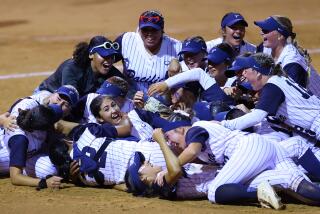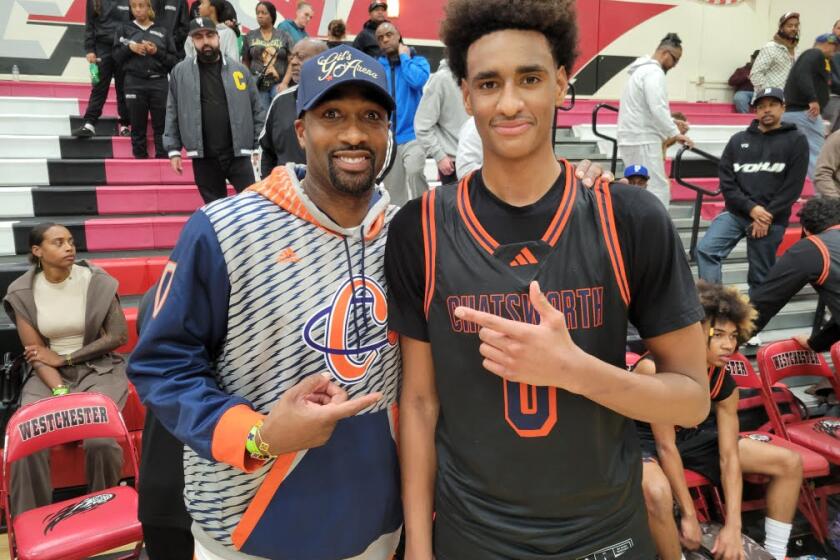For Some Pitchers, No-Hitters Becoming an Everyday Event : High schools: Softball no-hitters are increasing, prompting some coaches to suggest that it’s time to move the pitching rubber from 40 to 43 feet.
First, the evidence.
Since the high school softball season started last month, there have been 44 no-hitters in Orange County, including seven perfect games.
Hardly a day goes by without someone adding to those totals, and the county is on pace to easily surpass the 50 no-hitters pitched last year. Multiple no-hitters on the same day have been common; there were four on March 21 and April 9.
Such games were infrequent in the early 1980s, before Valencia’s Michelle Granger burst onto the scene in 1985 and pitched the first eight of her national-record 36 career no-hitters.
The county no longer has a dominating pitcher such as Granger, who is now at California. But plenty of girls this year have turned softball diamonds into fields of nightmares for opposing batters.
There is Desi Abrego, the Saddleback right-hander who has added three perfect games to her resume. And there is Alison Ward of Woodbridge, who is only one perfect game behind Abrego. Foothill junior Leeann Gonzalez has three no-hitters, followed by a host of others with two and one apiece.
All of which has made for softball games with slightly less action than a boccie match. For example:
* In her perfect game March 7, Capistrano Valley’s Jennifer Smith struck out 15 of 21 batters she faced in a 12-0 victory over Santa Ana Valley.
* In a combined no-hitter with Bridget Thackery on March 22, Fountain Valley’s Rae Rice struck out 12 batters in her five innings of work against Edison.
* In her second perfect game of the season, Abrego fanned 12 Corona del Mar batters in a game called after five innings because of the mercy rule.
All this has some folks wondering how to spice things up a bit. The dominance of the pitchers has prompted some high school coaches to suggest that perhaps it’s time to move the pitching rubber from the present distance of 40 feet from the plate to 43 feet, as it is in college.
Tall pitchers with long strides--Garden Grove’s Kim Taylor, for example, is 5 feet 10 and has two no-hitters this season--release the ball even closer than 40 feet from the plate. And with risers (fastballs that move upward) that can look like 90-m.p.h. deliveries in baseball, batters can typically only hope that the ball hits the bat instead of the other way around.
Mater Dei Coach Cathy Quesnell favors changing the distance.
“If it makes the game more exciting, sure,” Quesnell said. “Right now, the batter’s reaction time is nil. It might bring up the confidence level of the batters.”
Canyon Coach Lance Eddy agrees, although he doesn’t think some no-hitters mean much. Eddy says many are achieved by dominant pitchers against inferior competition.
“It’s such a misleading statistic, unless you consider who the teams are playing against,” Eddy said. “Saddleback no-hits Corona del Mar. Big deal.”
Said Fountain Valley Coach Cary Baker: “It would help the game offensively. In college, you don’t see that many strikeouts. I can’t think of any reason why it shouldn’t be 43 feet.”
Perhaps Baker can’t, but the National Federation of State High School Athletic Assns.offers a different perspective.
“We believe that the pitching rule as it stands is quite satisfactory,” said Brad Rumble, an assistant director at the federation’s offices in Kansas City, Mo. “There’s no national movement pushing to change the rule. There’s no interest in that.”
Rumble said he doubts there will be much interest in such a change, which would have to be approved at both the state and national levels, because it would threaten the marginal softball programs already hard-pressed to find top pitchers.
That view is shared by Cal State Fullerton pitching coach Kathy Van Wyk, who worries that the added distance would create too much of a gap between the outstanding pitchers and the less successful ones.
“I would question moving it back at the high school level,” Van Wyk said. “It’s the pitchers below the ones who throw the no-hitters who will suffer. I think it would destroy the mediocre pitchers in high schools.”
On the other hand, some of the county’s high school coaches say that moving the rubber back would give college-bound pitchers an opportunity to adjust to the distance for two or three years instead of practically overnight.
“It’s like field-goal kickers (in football) going to the grass after kicking off a tee,” Baker said.
Even Van Wyk admits they have a point.
“The main difficulty for high school pitchers when they get to college is that it requires them to be a lot more intelligent (when pitching),” Van Wyk said. “They have to be able to spot their pitches better, and that’s very, very difficult without a changeup. In high school, at 40 feet, they are not required to use the changeup that often so they don’t work on it that much.”
Perhaps high school pitchers would dominate less, and even benefit, by the added distance. But Irvine Coach Lisa Limp doesn’t think hitting would improve much, or stay improved for very long.
“It will open up the offense a little bit more, but the pitchers eventually will adjust,” she said.
That’s not exactly what high school batters in the county wanted to hear.
More to Read
Get our high school sports newsletter
Prep Rally is devoted to the SoCal high school sports experience, bringing you scores, stories and a behind-the-scenes look at what makes prep sports so popular.
You may occasionally receive promotional content from the Los Angeles Times.






